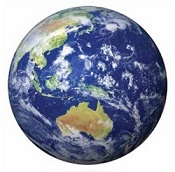- …without drastic cuts in global greenhouse gas emissions–more drastic than any being discussed ahead of the critical climate meeting in Paris later this year—a rise of 20 metres will soon be unavoidable.
Tag Archives: Antarctica
Climate clippings 139
1. Melting Antarctica: the time to act is now
In the link above, Graham Readfearn goes into some detail on the likely melting prospects of East Antarctica in particular. The salient points are as follows: Continue reading Climate clippings 139
Climate clippings 136
1. Will Hillary Clinton be too weak on climate change?

Campaign chair John Podesta tweeted:
Helping working families succeed, building small businesses, tackling climate change & clean energy. Top of the agenda.
Yet she herself has mentioned it only obliquely since announcing that she’s running. From the past we have this:
At the National Clean Energy Summit in September of last year, in her first major domestic policy address since stepping down from the state department, Clinton described global warming as “the most consequential, urgent, sweeping collection of challenges we face as a nation and a world”. Continue reading Climate clippings 136
Climate clippings 132
1. Accelerating ice loss from Antarctica shelves
Some ice shelves in Antarctica are thickening and some are thinning. The pattern between east and west is obvious from this image:
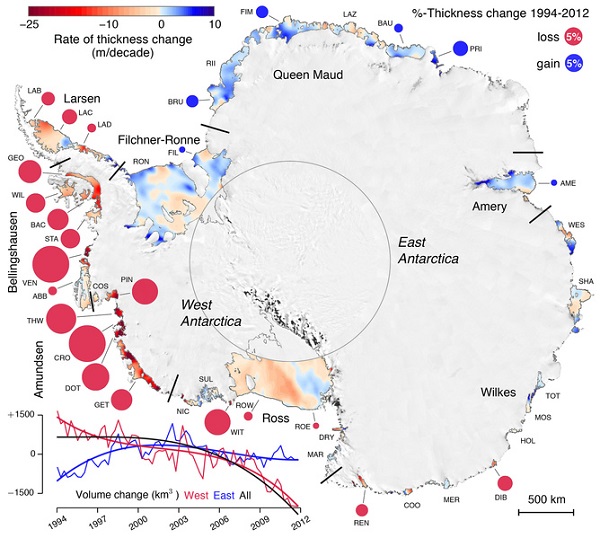
When we sum up losses around Antarctica, we find that the change in volume of all the ice shelves was almost zero in the first decade of our record (1994-2003) but, on average, over 300 cubic kilometers per year were lost between 2003 and 2012.
According to the ABC story, some shelves lost almost 20% of their thickness.
Melting ice shelves does not itself cause sea level rise, but the shelves buttress land ice, which then becomes more mobile. The graph in the bottom corner of the image shows that East Antarctica is now also experiencing a net loss of ice from ice shelves.
2. Top polluters to set own limits virtually penalty free
ANU economist Frank Jotzo said the system is designed so no-one gets caught by it – a toothless tiger. Tony Wood of the Grattan Institute said the ideas proposed in the paper simply would not work. They were commenting on a Government consultation paper outlining “safeguards” to ensure the big polluters do not offset emissions saved through the Emission Reduction Fund (ERF), a flagship component of Direct Action.
Australia’s 140 top polluters will set their own limits for future pollution virtually penalty free, according to the Government’s latest Direct Action policy paper.
Companies subject to the safeguards will select a baseline, or limit, for future pollution.
That baseline will be set according to the highest peak of emissions from the past five years.
Just plain stoopid!
3. What’s going on in the North Atlantic?
Stefan Rahmstorf asks the question at RealClimate. There is a large patch in the North Atlantic which has cooled in the last century.
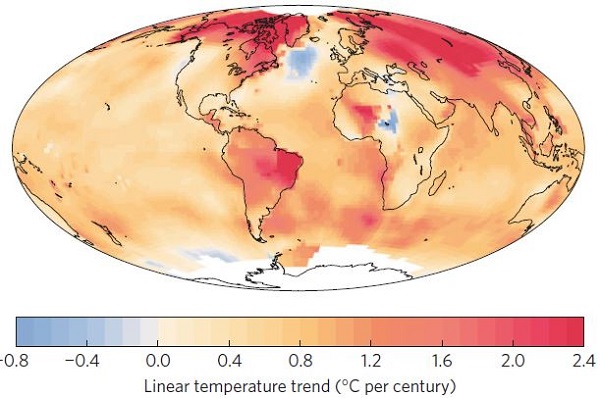
Rahmstorf explains:
Our recent study (Rahmstorf et al. 2015) attributes this to a weakening of the Gulf Stream System, which is apparently unique in the last thousand years.
In fact during last winter, which was the warmest on record for the planet overall, this patch had the coldest temperatures on record.
Chief suspect has to be the increasing freshwater coming off Greenland. There will be consequences.
The consequences of a large reduction in ocean overturning would look nothing like the Hollywood film The Day After Tomorrow. But they would not be harmless either – e.g. for sea level (Levermann et al. 2005) particularly along the US east coast (Yin et al. 2009), marine ecosystems, fisheries and possibly even storminess in Europe (Woollings et al. 2012).
A complete breakdown of the current was given up to a 10% chance this century in the IPCC report. This may have been an underestimate.
4. Rapid Arctic warming is changing the Jetstream and the weather
Another study, also involving Rahmstorf, looks at changing atmospheric circulation patterns due to Arctic warming.
The Arctic is warming faster than lower latitudes. The Jetstream velocity depends on temperature difference, hence it is slowing. It is also more wavy and has a tendency to get stuck, so heat or cold persists over a large area. Ironically, there is less storminess. Storms transport water onto land and break up persistent weather patterns.
The jet stream that circles Earth’s north pole travels west to east. But when the jet stream interacts with a Rossby wave, as shown here, the winds can wander far north and south.
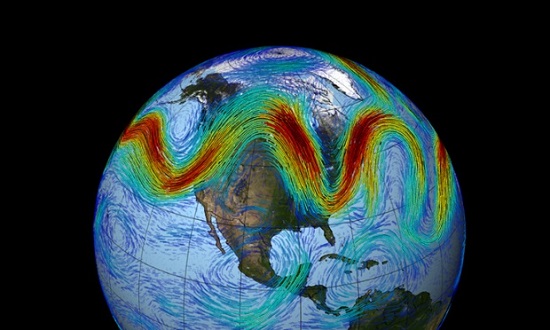
5. Brisbane EV charging technology takes on the world
Brisbane-based electric vehicle infrastructure company, Tritium, has done a deal to supply its award-winning Veefil DC fast charging stations to America’s ChargePoint company. ChargePoint has 21,000 EV chargers around the US.
The Australian-made stations will be installed on major routes across the country, including the express charging corridors on both the east and west coasts of the US that are being built as part of a recent deal between ChargePoint, Volkswagen and BMW.
The 50kW Veefil stations – which in the US will be called DC Fast stations and will be ChargePoint branded – are able to deliver up to 80 miles or 128 kilometers of charge in just 20 minutes, thus removing one of the key barriers to EV uptake: range anxiety.
Climate clippings 131
1. Totten Glacier
In Climate clippings 124 I mentioned concerns about Totten Glacier in East Antarctica, which is actively melting. It’s now in the news again. Dr Tas van Ommen:
“We’re realising that the East Antarctic ice sheet’s probably not the sleeping giant that we thought or at least, the giant’s starting to twitch and we’re concerned,” he said.
This article has a map showing the size of the glacier catchment, more than double Victoria:

Essentially with East Antarctica on the move, estimations of sea level rise this century could be underdone. We simply don’t know.
The Federal and Queensland Governments have together released the final version of the long-term plan for the Great Barrier Reef.
The Reef 2050 Long-Term Sustainability Plan satisfies one of the key recommendations made by the United Nation’s World Heritage Committee and forms a key plank in the Governments’ bid to avoid the site being declared “in danger” by UNESCO.
The report warns climate change is the biggest long-term threat facing the reef, while the immediate pressures include water quality, which has declined due to nutrient and sediment runoff from agricultural production.
Previously, a draft version of the report was criticised by some scientists as being a plan for sustainable development rather than protecting and conserving the reef.
The Queensland Government also sought urgent changes to the draft, to include its $100 million election commitment to improve water quality.
These news items never mention ocean acidification. As I’ve repeatedly warned:
It has been shown that “preserving more than 10 per cent of coral reefs worldwide would require limiting warming to below +1.5°C (atmosphere–ocean general circulation models (AOGCMs) range: 1.3–1.8°C) relative to pre-industrial levels”.
3. France says new rooftops must go green
According to a new French law approved on Thursday, rooftops on new buildings in commercial zones across France must either be partially covered in plants or solar panels.
France has lagged behind other major European countries like Germany, Italy and Spain in solar power development. As of last summer, France had just over five gigawatts of photovoltaic capacity, accounting for around one percent of total energy consumption. Germany has nearly 40 GWs installed.
France has relied on nukes for 83% of its power.
4. Are the UK’s emissions really falling?
Traditional emissions accounting only considers the greenhouse gases generated within a country’s own borders. In other words, emissions produced in the UK are allocated to the UK. On this measure, UK emissions have fallen dramatically to around 25% below 1990 levels.
But when the source of emissions generated by products consumed within the UK are counted, emissions have only fallen by 7%. This is the pattern over time:
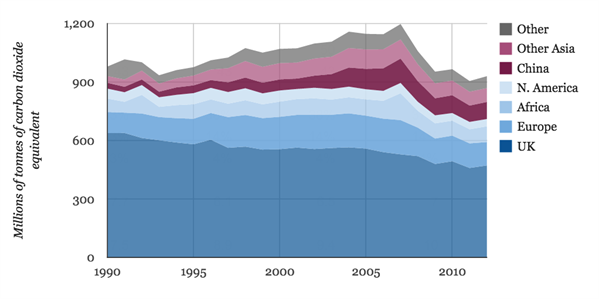
The UK’s production emissions have fallen fast (dark blue area), but imports have offset much of the gain (lighter blues, purples and grey area). Clearly things changed after the GFC in 2008.
5. Germany penalises dirty coal power
Germany plans to force operators of coal plants to curb production at their oldest and most-polluting power stations, as part of efforts to achieve its climate targets, senior government sources said yesterday. Under the measures, the government plans to allow coal plants to produce 7 million tonnes of carbon dioxide per gigawatt of installed capacity, but any produced above that level would be subject to a fine of 18 to 20 euros per ton.
6. Australia’s top ten emitters
Planet Oz takes a look at an ACF report on Australia’s top polluting companies. From the report here they are:
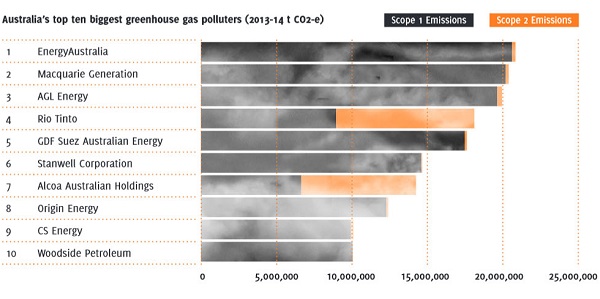
Seven are energy companies, three are miners.
However, if you took the emissions generated from the products they produce, a very different picture would emerge. Rio, for example comes fourth with emissions of 18 million tonnes of CO2 last year. Yet Rio’s customers burning coal produce a further 129 million tonnes.
7. Climate change ‘exacerbated’ Cyclone Pam damage
That’s according to the Climate Council, (but see Item 8 below).
“Higher surface temperatures can mean that you have higher wind speed and more damaging rainfall,” Amanda McKenzie from the Council said.
“And what we saw in Vanuatu was in the lead-up to the cyclone, sea surface temperatures were well above average.”
Ms McKenzie said rising sea levels would multiply the damaging effects of cyclone storm surges.
Cyclone Pam, a category-5 storm with wind gusts reaching 300 km/h, struck Vanuatu on 13 March 2015 leaving twenty-four people dead, 100,000 people homeless and up to 70% of the nation’s 69,000 households damaged.
8. Cyclone Pam and Climate Change
Stefan Rahmstorf at RealClimate takes a look at whether climate change had an effect on Cyclone Pam.
My take is, quite possibly, but we can’t know for sure.
The basic problem is that the satellite record only goes back to around 1980, which is not long enough, and only in the North Atlantic are cyclones surveyed by aircraft and then only if they threaten populated regions within a few days.
A study by Kossin et al (2013) looked at the satellite data record from 1982 to 2009 and found an increase of 2.5 m/s per decade for high intensity events (Pam appears to have reached an intensity of around 75 m/s).
Other factors to look out for include the amount of rain delivered, changes in genesis locations and tracks, and diameters, all of which should be affected by climate change.
Haiyan and Pam, two of the most severe tropical cyclones on record, have struck the western Pacific in the past 16 months.
Climate clippings 124
1. Totten Glacier melting from below
Scientists have found that waters around Totten Glacier are warmer than expected and that it is melting from below. Amazingly the glacier, in East Antarctica, has never been studied before.
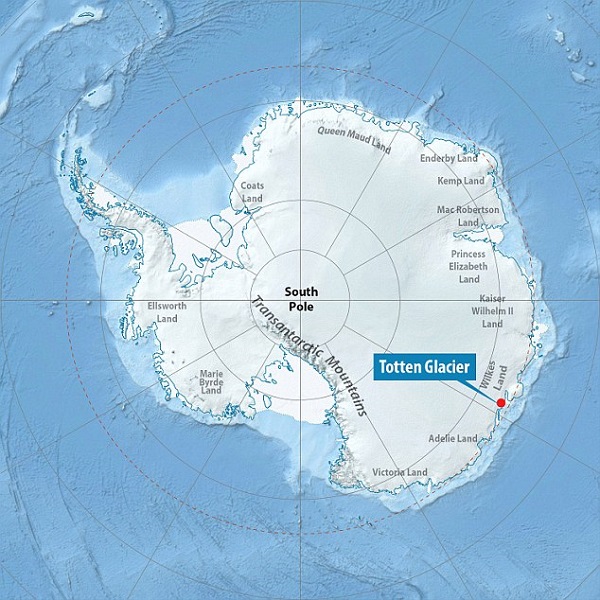
A team of scientists on the Australian icebreaker Aurora Australis has recently taken a look. They don’t have comparative historical data to go by, but the concern is large. Totten is the biggest of the big and holds enough water to raise the sea level 6 metres. That’s somewhere between West Antarctica and Greenland!
2. State of the Climate 2014
The CSIRO and the Bureau of Meteorology have released their State of the Climate 2014 report. There is a summary at the ABC.
One thing that was new was a prediction of more extreme El Niño and La Niña events. They are talking here of extreme La Niña’s appearing once in 13 years rather than once in 23 years. So it’s not the garden variety events, rather the exceptional events.
For the rest of the report, it seems on a quick look to be much as expected – less rainfall in southern Australia, more extreme hot days, less snow, continued ocean acidification, more worries about sea level rise and so on. I’ll take a closer look if I get time.
Graham Readfearn points out that in 1995 at Amberley near Brisbane the mercury climbed above 35C on 12 days per year on average. That could become 55 days per year.
3. Australian sport needs to lift game on climate issues, Olympians and sport bosses say
It has been a year since extreme heat wreaked havoc at the Australian Open, with players forced to endure temperatures over 40 degrees Celsius on the courts.
Some athletes said the conditions were akin to “tap-dancing on a fry pan”.
Unfortunately Tennis Australia are not on their lonesome in forcing athletes to perform in dangerous conditions. There are concerns also for spectators and venues, for example subject to flooding. The Climate Institute has produced a report analysing the vulnerability amongst sports like AFL, tennis, cricket and cycling as well as winter snow sports.
Part of The Climate Institute’s ongoing research into climate risk and resilience, this report will form the basis of ongoing discussions in the sporting world, including with the newly formed Sports Environment Alliance, chaired by former International Cricket Council CEO Malcolm Speed.
4. Keystone showdown and American climate opinion
The Senate has passed legislation approving the controversial Keystone XL tar sands oil pipeline on a 62-36 vote.
asked Thursday about the vote, White House Press Secretary Josh Earnest reiterated that Obama would veto.
The Senate requires 67 votes to overturn a presidential veto.
Meanwhile Carbon Brief takes a look at the gap in opinion between scientists, the public, and politicians on climate change from Pew Center research. This is how it pans out:
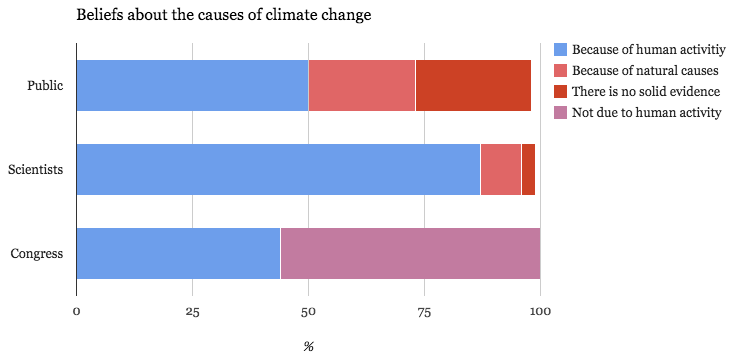
A case of the blind leading the partially sighted.
Across the ditch Hot Topic posts about a book that meticulously goes through the development of climate science from the time of Arrhenius. Seriously, there isn’t an argument any more about the basic science.
5. Economists begin to take climate change, and poverty, seriously
I find this surprising:
current economic models… generally conclude that the economically optimal pathway results in a global surface warming around 3–3.5°C.
Current economic models mainly treat economic growth as an external factor. In these models, global warming and its impacts via climate change don’t significantly affect the rate at which the economy grows.
A new study finds:
while the economies of rich countries continue to grow well in a warmer world, the economic growth of poor countries is significantly impaired.
That’s not so surprising.
The authors find that:
the best path for society would limit temperatures to between 1.6 and 2.8°C warming in 2100, with a best estimate of around 1.7°C warming.
Meanwhile the rulers of the world at the Davos World Economic Forum conference were given a straight message:
In particular, the nexus between climate protection and development is a striking conclusion of the World Bank analysis: without climate stabilization at still manageable levels, development advances, especially in the poorest countries, are set to be reversed. Indeed, development work of past decades (involving significant financial resources) is at risk and with it the well-being of the most vulnerable citizens on Earth.
The “World Bank analysis” is Turn down the heat : confronting the new climate normal, a report prepared for the World Bank by the Potsdam Institute for Climate Impact Research and Climate Analytics.
Climate clippings 118
1. Growth in CO2 slows
Global carbon dioxide (CO2) emissions from fossil fuel use and cement production grew 2% in 2013 to the new record of 35.3 billion tonnes of CO2. This was about half the average for the last 10 years and less than global GDP growth of 3.1%.
2. Aradhna Tripati gets a gong
The Center for Biological Diversity presented its third annual E.O. Wilson Award for Outstanding Science in Biodiversity Conservation to Dr. Aradhna Tripati for her groundbreaking research on carbon dioxide’s role in climate change.
Tripati’s work revealed that the last time CO2 levels were as high as they are today was 15 million to 20 million years ago, when the distribution of plants and animals was dramatically different, global temperatures were 5 to 10 degrees warmer, and the sea level was 75 to 120 feet higher than today. Her research suggests that the CO2 threshold for maintaining year-round Arctic ice may be well below modern levels.
Converting from Fahrenheit to Celsius and feet to metres that would make 2.7 to 5.5°C and 23 to 36 metres.
I would caution that the shape of the ocean basins may have been different, but these are alarming findings.
3. 1000-year drought history of Queensland and New South Wales
By analysing ice cores Australian scientist have found that there were eight droughts in the last millennium that lasted more than five years, with one of the so-called mega droughts lasting for almost 40 years. That was back in the 12th century.
This tends to indicate that the Millennium Drought and the Big Dry from 1997 to 2009 were not unusual.
From the official news release:
Explaining the findings, Dr Vance said the ice core analysis had significantly enhanced our understanding of a relatively poorly understood phenomenon known as the Interdecadal Pacific Oscillation (IPO).
The IPO describes a roughly 25-year cycle in the sea surface temperature, wind and other factors in the Pacific Ocean.
The IPO’s positive phase is closely linked with longer and more severe droughts in the United States and Australia. The risk of droughts occurring in Australia is higher during the IPO’s positive phase.
I’m not questioning the findings but how drought in Queensland and NSW can be derived from drilling ice cores in the Antarctic is not immediately obvious.
Where does this leaves global warming? The authors don’t say, but the clear implication is that severe droughts are part of the natural cycle. Warming is a given. The most recent analysis I recall is that drying along the southern edge of the continent has a climate change component. North of the Victorian border there is uncertainty.
4. Lifters or leaners?
Or backmarkers. UK PM David Cameron thinks Australia does not want to be a “backmarker” on climate change action. Global pressure will make us do more. Has he met our Tones?
Christian Downie thinks the real achievement of the Lima climate talks
wasn’t the goals set, but the fact that international talks like these make it increasingly hard for breakaway countries to ignore the issue.
John Kerry spells it out:
“If you are a big developed nation and you do not lead, you are part of the problem.”
Part of the problem indeed, and perhaps an active climate change vandal. Kieran Cooke reports that in Lima Australia was “lobbying for rules that undermine the integrity of the emissions accounting system”.
5. Antarctic sea ice
One of the conundrums of climate science has been the question of why the Antarctic sea ice has been expanding. Eric Steig at RealClimate takes a detailed look. One of the complexities is that the sea ice is expanding in some places and contracting in others. This, he says, rules out simplistic notions like an increase in westerly winds.
However, if you take into account the changes in all the wind patterns in the Antarctic you get a better match, indeed a good match.
Finally Steig says:
Not incidentally, changing winds also have a lot to do with what’s been happening to the Antarctic ice sheet (meaning the land-based glaciers, distinct from the sea ice). I’ll have another post on that later this month, or in the New Year.
Climate clippings 117
1. Australia targeted as climate change obstacle
I pointed out that Australia is the dunce of the class on climate change according to the Climate Change Performance Index 2015.
Elsewhere the French are already considering how to cope with Australia’s and Canada’s negativity at the Paris conference next December.
2. Seeney in denial on sea level rise
That dipstick Jeff Seeney, Deputy Premier in Queensland, has directed the Moreton Council to remove all reference to sea level rise from, its planning documents:
“I direct council to amend its draft planning scheme to remove any assumption about a theoretical projected sea level rise from all and any provision of the scheme.”
The council had made provision for a possible 0.8-metre rise in sea level by the year 2100. Seeney says:
“I am prepared to protect the property rights of Queenslanders in other council areas should this issue arise again.”
Who is going to protect them from him? The Local Government Association of Queensland (LGAQ) is seeking legal advice.
Seeney claims the issue has nothing to do with climate change! Denial doesn’t come clearer than that!
3. West Antarctic melt rate has tripled
A NASA study has done a thorough analysis of the land ice melting in the Amundsen Sea Embayment where the glaciers are melting faster than any other area of Antarctica.
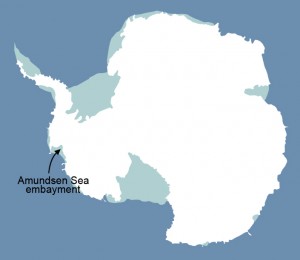
The rate of loss accelerated an average of 6.1 gigatons per year since 1992, but now the rate is increasing by 16.3 gigatons per year.
The total amount of loss averaged 83 gigatons each year over the whole period, that’s the equivalent of losing the weight of Mt Everest (not just the ice on it) every two years.
4. Warmer seas could cause faster melting of Antarctic ice
A separate study has found that the seas around Antarctica are warming, which could increase ice shelf melting.
Ice shelves float, so the melting does not cause sea level rise, but they buttress the land glaciers. Take away the ice shelves and the glaciers flow faster.
5. New large scale battery storage in Germany
Belectric and Vattenfall have opened new large-scale battery energy storage system at the Alt Daber solar power plant in Germany. The facility uses lead-acid batteries.
For the system to be economical without any financial support, costs will have to come down by around a third.
6. Solar and wind energy backed by huge majority of Australians
Solar and wind energy enjoy strong support from the Australian public, with 80% of people putting them both among their top three energy choices in a poll for the Australia Institute.
By contrast, coal and coal seam gas were chosen by 35% and 38% of those polled as being among the best three future energy sources.
A separate review of medical literature by the Australia Institute debunked the fear that wind power damaged people’s health, finding “no credible evidence” directly linking exposure to turbines with negative health effects.
Nine out of 10 people said they wanted more solar energy.
Six in 10 people said they were concerned about the impact of coal and coal seam gas on the landscape.
7. UNSW researchers set world record in solar energy efficiency
Solar researchers working at the University of New South Wales (UNSW) claim to have produced a system that converts over 40 percent of incoming sunlight into electricity, thereby taking the title of highest solar efficiency for a photovoltaic system ever reported.
“This is the highest efficiency ever reported for sunlight conversion into electricity,” said UNSW Professor Professor Martin Green, Director of the Australian Centre for Advanced Photovoltaics (ACAP).
8. The end of coal as we know it
And oil for that matter.
Graham Readfearn in Lima at the climate Conference of Parties has found these items in the negotiating text:
Parties’ efforts to take the form of:
a. A long-term zero emissions sustainable development pathway:
Consistent with emissions peaking for developed countries in 2015, with an aim of zero net emissions by 2050; in the context of equitable access to sustainable development;…
Consistent with carbon neutrality/net zero emissions by 2050, or full decarbonization by 2050 and/or negative emissions by 2100;….
He understands they were put there by Norway, the Marshall Islands, Sweden and the AILAC grouping of countries consisting of Chile, Colombia, Costa Rica, Guatemala, Peru and Panama.
Andrew Robb Bishop have noticed and are complaining. It will be interesting to see whether the statements stay.
Readfearn finds that a move for a zero emissions target is growing and Malte Meinshausen explains that it is inevitable if we are serious about staying within two degrees.
Climate clippings 109
1. Home solar power plus battery storage
It’s on the way, according to reports in Climate Progress and RenewEconomy. They are reporting on reports emerging from HBSC, Citigroup and UBS, so the big end of town is taking notice.
Initial interest is in short storage to cater for the peaks, but it seems that full storage systems will become competitive before the end of the decade.
For the next ten years battery technology is likely to remain lithium ion, with newer technologies introduced later.
2. Oceans warming faster than thought
The top 700 metres of the ocean have been warming 24 to 55% faster since 1970 than previously thought. The problem has been poor sampling in the Southern Ocean.
Of course this means that the whole planet has been warming faster than previously thought, since over 90% of the extra heat goes into the ocean.
3. Human hands caused 2013 heat
To me 2013 seems like a long time ago, but it is remembered for breaking a lot of heat records in Australia.
January 7 was our hottest day on record – 40.3°C.
January was the hottest month on record.
The 2012-13 summer was the hottest on record.
September was the hottest on record, exceeding the previous record by more than a degree; this was the largest temperature anomaly for any month yet recorded.
September-November was the hottest on record.
The whole year of 2013 was the hottest on record.
Five studies have now been done establishing human agency in these events. We don’t just need to be concerned about our grandchildren. Climate change caused by humans is happening now.
4. NOAA explains record Antarctic sea ice growth
First of all the record does not represent a dramatic increase on the recent average:
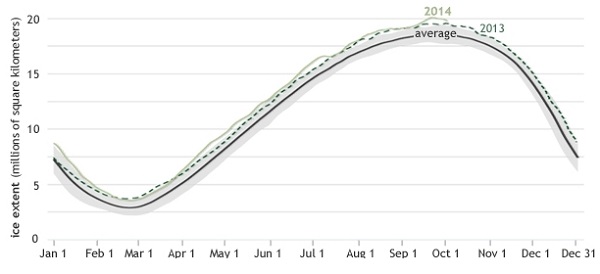
By comparison the loss of land ice has tripled in the last five years alone.
NOAA have now given a more detailed explanation of how the increase, counterintuitively, may be related to global warming. Firstly, it’s the wind:
NOAA first points out that “much of this year’s sea ice growth occurred late in the winter season, and weather records indicate that strong southerly winds blew over the Weddell Sea in mid-September 2014.”
Secondly, the melting land ice itself may have an effect:
Most of Antarctica’s ice lies in the ice sheets that cover the continent, and in recent decades, that ice has been melting. Along the coastline, ice shelves float on the ocean surface, and much of the recent melt may be driven by warm water from the deep ocean rising and making contact with ice shelf undersides.
How does the melting of land ice matter to sea ice formation? The resulting meltwater is fresher than the seawater. As it mixes with the seawater, the meltwater makes the nearby seawater slightly less dense, and slightly closer to the freezing point than the ocean water below. This less dense seawater spreads out across the ocean surface surrounding the continent, forming a stable pool of surface water that is close to the freezing point, and close to the ice onto which it could freeze.
5. Marshall Islands expendable
The United Nations chose 26-year-old Marshall Islands poet and mother Kathy Jetnil-Kijiner to be among the keynote speakers at the UN’s climate summit in New York recently. Here she is at the mike with her husband and child:

Marshall Islands sits on average about 2 metres above sea level. Already she’s seen waves crashing into their homes and their breadfruit trees wither from salt and droughts.
Jetnil-Kijiner was confident in her speech that, no matter how difficult, climate change would be solved, and her daughter would be able to go on living in the Marshall Islands.
“No one’s drowning, baby,” she said. “No one’s moving. No one’s losing their homeland. No one’s becoming a climate change refugee…We are drawing the line here.”
She said, accurately I think, that saving the Marshall Islands meant “ending carbon pollution within my lifetime.”
Some 125 world leaders were present. Some, like ours stayed away, having more important things to do. Anyone present with half a brain must have known that is not going to happen. The Marshall Islands is expendable.
6. Climate outlook, October to December
In brief, warmer and drier than average, apart from Tasmania, which looks good for rain. There’s more detail and maps here.
This is what the rainfall prospect looks like:
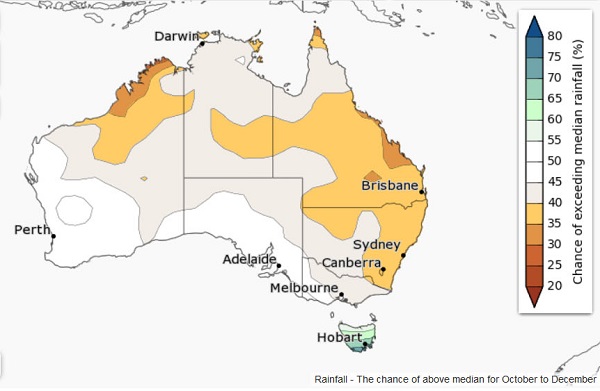
And maximum temperature:
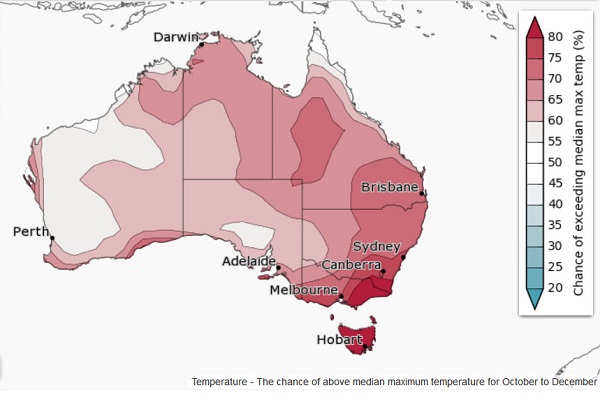
Six of eight international climate models suggest a late season El Niño, or near El Niño, ENSO state is likely.
Climate clippings 106
1. Abbott adviser warns of threat of ‘global cooling’
Nevertheless with the certainty only possessed by fools, the Abbott government’s chief business adviser, Maurice Newman, has warned that Australia is ill prepared for global cooling owing to widespread “warming propaganda” in his latest critique of mainstream climate science.
The suggestion is that temperature change is due to changes in solar activity, cosmic rays and stuff. The science is heading in the opposite direction.
“The sun doesn’t have as much influence on the climate as we previously thought, the latest estimates are that it explains only 5% of the warming over the last 150 years,” he said.
How can the government be advised by someone who is so ill-informed about arguably the biggest single influence on business conditions over the next century.
We’ve just had the hottest August globally since records began being kept in 1880, according to NASA. The year to date has been the fourth hottest on record. Hot years usually coincide with an El Niño either in the year concerned or the previous year. An El Niño has not yet arrived but does look likely according to the latest information.
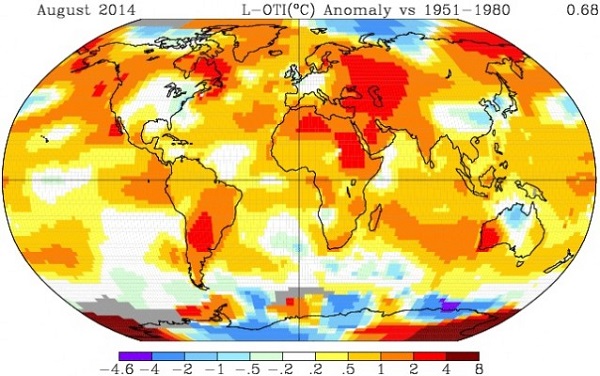
It has been especially hot in West Antarctica. Bear that in mind when you see stories of record sea ice around Antarctica:
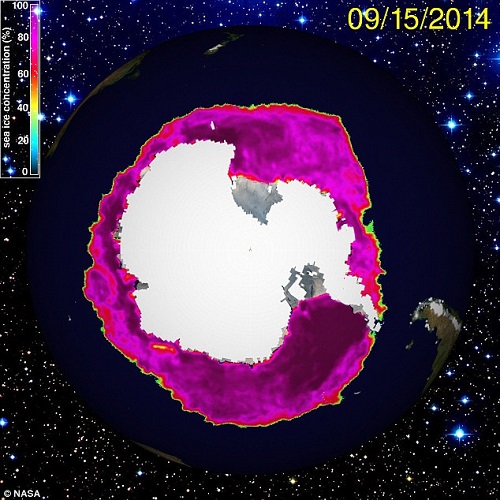
This is not incompatible with global warming and could in fact be caused by it. Melting ice produces cold water, and the tightening wind pattern tend to blow the ice further north.
There is no information as yet on ice volume.
3. Australian Climate Action Summit 2014
The Australian Climate Action Summit 2014 is on this weekend. Since my life is governed by work, the weather and medical appointments I am unable to go.
On Sunday there will be a People’s Climate March, organised by an outfit called Avaaz. Marches will be organised all around the world, and indeed, all around Australia, including, for example Mt Isa and the Gold Coast. If you click on Brisbane you get the Summit, but if you click on the Summit you don’t get a march. So if there is a march in Brisbane, I can guess where but I’d also need to guess when.
The march is meant to impress the leaders gathering in New York on Tuesday 23 September. That’s the UN Summit Tony Abbott will not attend although he’ll be in New York on Wednesday.
4. Surviving in hot, acidic oceans
I think this is a good news story.
More than 90% of the extra heat in global warming ends up in the oceans, as does 25% of the CO2 we create, which makes the oceans more acidic. Shell-making organisms such as plankton are expected to be in trouble. The good news is that it seems one species of plankton, the Emiliania huxleyi, can survive the changes underway.
5. Climate Council report on sea level
The Climate Council has taken another look at climate change and coastal flooding. The focus is on 1.1 metres sea level rise by 2100, all too possible if West Antarctica is in play, as it seems to be.
We are told that the frequency of flooding events can treble for every 10 cm of sea level rise. The risk multiplier depends where you are. In Sydney, Bundaberg and Hobart, for example a current 1 in 100 year event now could be happening every day by 2100. In Adelaide, the least at risk city, it would be only once every year.
At risk we have $87 billion worth of commercial and light industrial buildings, $72 billion worth of homes and $67 billion worth of roads and rail infrastructure.
Joe Romm tells us about Naomi Klein’s new book, This Changes Everything: Capitalism Vs. The Climate. Klein, he says, makes three essential points:
1. Because we have ignored the increasingly urgent warnings and pleas for action from climate scientists for a quarter century (!) now, the incremental or evolutionary paths to avert catastrophic global warming that we might have been able to take in the past are closed to us.
2. Humanity faces a stark choice as a result: The end of civilization as we know it or the end of capitalism as we know it.
3. Choosing “unregulated capitalism” over human civilization would be a “morally monstrous” choice — and so the winning message for the climate movement is a moral one.
The time for ‘evolutionary’ strategies is long past. Now only ‘revolutionary’ strategies will get us there. Unregulated capitalism is a Ponzi scheme, which must collapse. The real choice facing us is a moral one.
Unchecked capitalism is immoral and will destroy civilisation as we know it. Just what Klein says we should do will be covered by Romm in a subsequent post.
Climate clippings 105
1. Atlantic Ocean important for heat storage
Most of the energy from global warming goes into the ocean as this graphic from Skeptical Science illustrates:

The linked paper stresses the role of the Atlantic in heat uptake. The following graph shows the heat uptake for the four main oceans. The black line is the sea surface temperature, the red line shows the heat below 1500 metres.
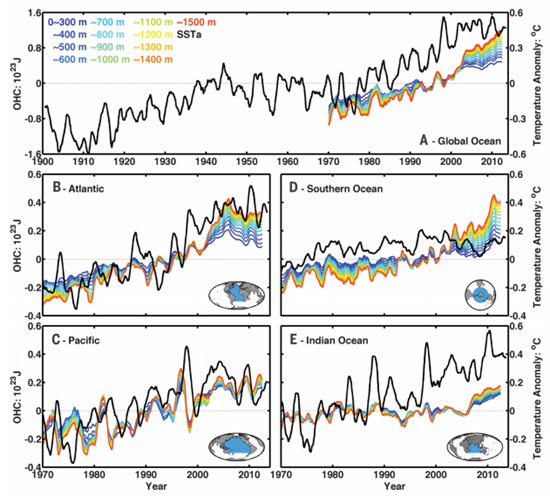
All this is considered in relation to the socalled warming ‘hiatus’. The suggestion is that the Atlantic Meridional Overturning Circulation is the critical influence and it changes phase every 20 to 35 years. If so the ‘hiatus’ could last another decade or so.
Other scientists see the hiatus as multi-causal. It also depends which temperature series you are looking at. The HadCRUT temperatures always look flatter in recent years, as in this article. The Gistemp series from NASA has 1998 as about the third highest and shows a continuing upward trend, albeit slowed..
2. ‘Unprecedented’ ice loss in Greenland and Antarctica
Since 2009 the volume of ice loss has tripled in West Antarctica and more than doubled in Greenland, the highest rate of ice loss since satellite records began 20 years ago.
While it’s still early days, sea level rise this century could surprise on the upside.
Carbon Brief also have the latest on the chances of an El Niño developing in 2014, which the Australian BOM now put at about 50%. Earlier there was talk of a super El Niño, which is still possible.
4. China gets into emissions trading
The Chinese national market will start in 2016.
The Chinese market, when fully functional, would dwarf the European emissions trading system, which is now the world’s biggest.
It would be the main carbon trading hub in Asia and the Pacific, where Kazakhstan and New Zealand already operate similar markets. South Korea will start a national market on Jan. 1, 2015, while Indonesia, Thailand and Vietnam are drawing up plans for markets of their own.
Looks like quite a trend. Time perhaps for Australia to join in!
5. World’s poor need grid power, not just solar panels
Small scale solar power is quite popular in Africa and supported by environmentalists. A few panels are able to run a few lights, a radio, charge the mobile phone but stop short of boiling a kettle. Critics see this as condemning the poor to a constrained future. Only 20% of Kenyans are connected to the grid.
Coal fired power is obviously not the answer. Dams take years to build, are typically over budget, inundate fertile lands or forest areas and interrupt natural stream flow.
In the Democratic Republic of Congo the mega project of the Inga 3 dam is due to start construction on the Congo River. If fully developed it will produce twice as much electricity as the world’s largest, the three Gorges in China. But will it be economically justified and what impacts will it have on the environment?
6. Emissions from energy generation jump after carbon price axed
Carbon emissions from the country’s main electricity grid have risen since the end of the carbon tax by the largest amount in nearly eight years.
Data from the National Electricity Market, which covers about 80 per cent of Australia’s population, shows that emissions from the sector rose by about 1 million tonnes, or 0.8 per cent, at an annualised rate last month compared with June.
That is the biggest two-month increase since the end of 2006, and came as a result of an increase in overall demand and a rise in the share of coal-fired power in the market, according to Pitt & Sherry’s monthly Cedex emissions index.
From what I can make of it, gas is increasingly going to export, there is some scaling back of hydro, presumably because of the weather. and large scale solar was killed off ages ago. The slack is being taken up by old coal, including brown coal.
Abbott’s strategy of saving the coal fired power industry seems to be working.
Building new more efficient coal would be his ultimate aim. This would involve investors and lenders having confidence in the future of coal. Surely they can’t be that stupid!
Reminder: Use this thread as an open thread on climate change.
Climate clippings 102
This week we start with trouble at the top and bottom of the world and finish with trouble with our leading media magnate and politician.
1. Geenland at a tipping point?
THE cracks are beginning to show. Greenland’s ice sheets slid into the sea 400,000 years ago, when Earth was only a little warmer than it is today. That could mean we are set for a repeat performance.
If Greenland goes, West Antarctica also goes, giving 13 metres of sea level rise from those sources. If that happens there will also be a complete loss of other glaciers and ice caps, thermal expansion and some partial melting from East Antarctica. A mess!
The question is how soon and what can we do? The answer is we need more research and we need to think more in terms of centuries.
We should be thinking about the next 500-1000 years, how ice sheet decay can be minimised, stabilised and headed in the other direction. Our plans for the next 50-200 years should be made in the light of this.
This image from the article shows a part of Greenland where the ice is quite dynamic.These areas are expected to grow.
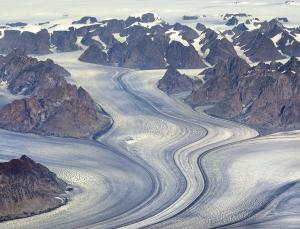
Here’s an image from another article:
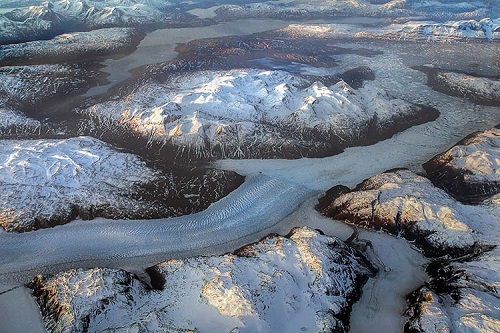
2. Big trouble in the Antarctic has been brewing for a long time
David Spratt at Climate Code Red:
“A game changer” is how climate scientist Dr Malte Meinshausen describes newly published research that West Antarctic glaciers have passed a tipping point much earlier than expected and their disintegration is now “unstoppable” at just the current level of global warming. The research findings have shocked the scientific community. “This Is What a Holy Shit Moment for Global Warming Looks Like,” ran a headline in Mother Jones magazine.
Meinshausen says this is new information. He says that the beaches we know and love all around the world will disappear. He also wonders what other nasty surprises lie this side of a 2°C temperature rise. Spratt says we told you ages ago it was coming, by James Hansen, for example and by himself and Philip Sutton in 2007.
This NASA image shows the temperature changes from 1957 to 2006:
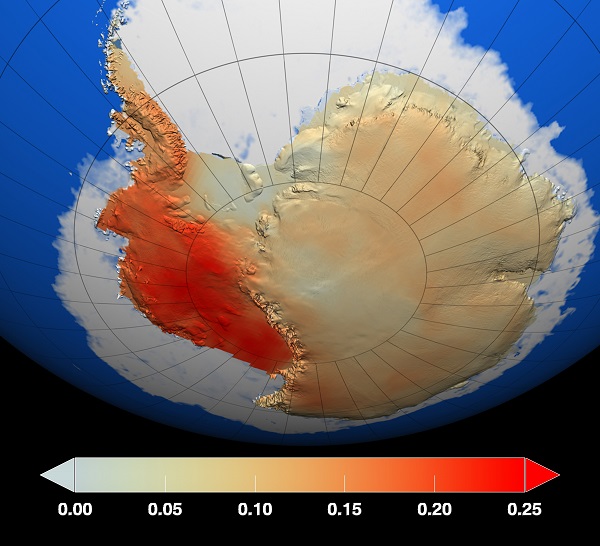
Hansen warned; Meinshausen says it’s happening. Spratt warns:
It’s par for the course for climate policy-makers to hope for the best, rather than plan for the worst. More than once this blog has warned that sea-level rises are being underestimated by Australian policy-makers, and that the tens of millions of dollars being put into adaptation planning for sea-level rises of no more than 1.1 metres by 2100 will be a waste of money, and all that work will have to be done again. And now that has come to pass.
3. Huge ‘whirlpools’ in the ocean are driving the weather
GIANT “whirlpools” in the ocean carry far more water than expected and have a big impact on the weather – though as yet we don’t know exactly what.
The areas of swirling water are 100 to 500 kilometres across. These “eddies” generally move west, driven by Earth’s rotation, until they stop spinning. Now, for the first time, the amount of water and heat they carry has been measured.
Article and image available also here.
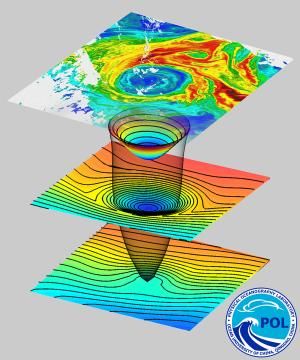
Nestled into the pastoral landscape of Treviso, Italy, BioCasa_82 is a beautiful home that boasts some seriously energy-efficient technologies.
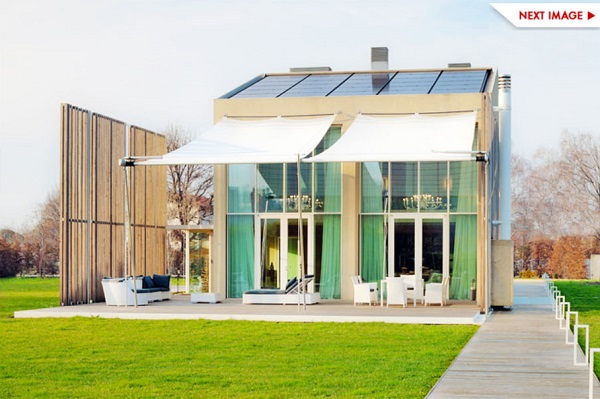
The house is made from 99% recyclable materials and scores
117 points out of 136, according to the American protocol LEED Platinum, and 10 out of 11 points in regards to innovation in design, the building is a real gem in the European building practice.
According to the carbon footprint analysis, BioCasa_82 yields 60% less emissions than traditional buildings. Its photovoltaic system produces around 14kWh/mq of electricity, and a high-efficiency geothermal plant provides heat, hot water and cooling. These strategies are complemented by a rainwater harvesting system.
5. Rupert Murdoch doesn’t understand climate change basics
That is everyone’s problem since he owns a world-wide media empire.
Many of Murdoch’s news outlets are also among the worst when it comes to getting climate science wrong and disseminating climate myths and misinformation. Inaccurate media coverage is in turn the primary reason why the public is so misinformed about global warming.
I won’t go into the details, but Climate Progress observes that he ‘lowballed’ the numbers and minimized possible impacts. Here in Oz:
”We can be the low-cost energy country in the world,” he said. “We shouldn’t be building windmills and all that rubbish.”
Elsewhere Graham Readfearn finds that Tony Abbott’s views on climate are seriously crap.
Reminder: Use this thread as an open thread on climate change.


